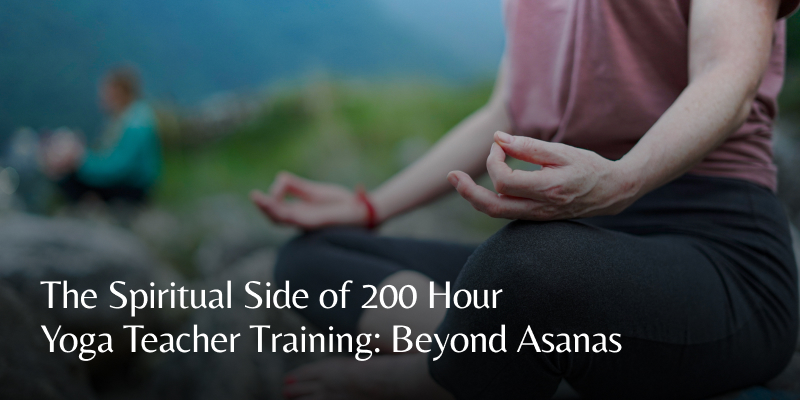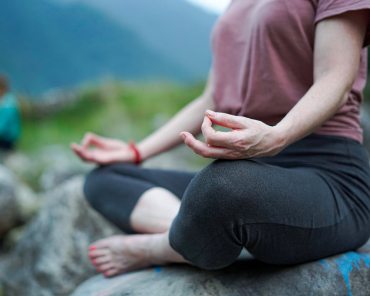
Introduction
When most people think of yoga, they imagine flowing postures, impressive flexibility, and perhaps a bit of calm breathing. But if you’ve ever taken a deep dive into yoga—especially through a 200 Hour Yoga Teacher Training (YTT)—you know that it goes far beyond the physical.
Yoga is, at its core, a spiritual journey. While asanas (postures) are an important part of the training, they are only one small piece of the bigger puzzle. In this blog, we’ll explore the lesser-discussed but deeply transformative spiritual side of a 200 Hour YTT—the part that truly stays with you long after your certification.
Yoga is More Than Just Physical Postures
Yoga is often misunderstood as a workout or a form of stretching. But its purpose is far greater—it is a tool for self-realization.
In ancient texts like the Yoga Sutras of Patanjali, yoga is defined as “Chitta Vritti Nirodha”—the stilling of the fluctuations of the mind. This means the postures we practice on the mat are meant to prepare the body and mind for deeper internal work like meditation, breath control, and ultimately, self-awareness.
Spiritual Dimensions of a 200 Hour Yoga Teacher Training
Let’s break down the core spiritual elements you’ll likely experience during your training:
Understanding the Yogic Philosophy and the Eight Limbs of Yoga
One of the first things you’ll dive into is the Eight Limbs of Yoga, which go far beyond physical postures. These include ethical guidelines (Yamas and Niyamas), breath control (Pranayama), concentration (Dharana), meditation (Dhyana), and more.
Studying these limbs opens your mind to yoga as a lifestyle, not just a physical activity.
Read More: Why Is Kundalini Yoga Dangerous? The Truth About Its Risks and Rewards
The Role of Meditation and Inner Awareness
Daily meditation sessions in a YTT aren’t just about sitting still—they’re about learning to observe. You begin noticing your thoughts, your reactions, your patterns. Slowly, you become more grounded, less reactive, and more in tune with your inner world.
This mental stillness becomes your anchor, even off the mat.
Practicing Pranayama: Breath as a Gateway to Stillness
Pranayama (breath control) is often underestimated. But once you begin practicing techniques like Nadi Shodhana or Kapalabhati regularly, you’ll feel the energetic shift within.
The breath becomes your bridge between the body and the mind—helping you access deeper states of calm and awareness.
Self-Inquiry and Journaling for Personal Growth
During YTT, you’ll likely be encouraged to journal your experiences, thoughts, and emotions. This simple practice turns into a mirror.
You uncover parts of yourself that you’ve ignored, repressed, or never realized. The journey inward becomes just as meaningful as mastering any pose.
Living the Yamas and Niyamas (Ethical Foundations of Yoga)
The Yamas and Niyamas are yogic principles for living a conscious and ethical life. From practicing non-violence (Ahimsa) to contentment (Santosha), these guidelines shape the way you interact with yourself and the world.
In YTT, you don’t just learn about them—you live them.
Mantras and Chanting: Connecting with Vibrational Energy
Chanting mantras like “Om” or the Gayatri Mantra may feel unusual at first—but over time, you begin to feel their subtle power.
These sound vibrations carry centuries of intention and energy, and they help you drop out of the analytical mind and into the heart.
Developing Presence and Mindfulness in Daily Life
YTT teaches you to slow down. From eating with intention to walking mindfully, you begin to bring awareness into the little things.
And that’s the heart of spirituality—not escaping life, but being fully present in it.
Learning to Let Go of Ego and Embrace Surrender (Ishvara Pranidhana)
One of the most humbling lessons in yoga is that not every pose will be perfect, and not every moment will be comfortable.
The practice of Ishvara Pranidhana, or surrender to the higher self or universal force, teaches you to release control, let go of ego, and trust the journey.
The Power of Silence and Solitude During Training
Whether it’s a silent meditation session or simply sitting alone with your thoughts, moments of silence in YTT help you connect with something deeper than words.
In those quiet spaces, transformation begins.
Creating a Sacred Inner Space
As you go through the course, your yoga mat starts to feel like a sacred space. Eventually, you realize that this sacredness doesn’t stay on the mat—it lives within you.
You begin to carry this inner sanctuary wherever you go.
How Spirituality Shapes You as a Yoga Teacher
By the end of your 200 Hour YTT, you may walk away with better alignment cues and teaching techniques—but more importantly, you walk away with a deeper sense of self.
You don’t just teach yoga poses—you teach presence, peace, and transformation. Your authenticity and inner grounding naturally shine through in your teaching.
Conclusion
The physical side of yoga is what brings most people to the mat—but it’s the spiritual journey that keeps them there. A 200 Hour Yoga Teacher Training doesn’t just teach you how to teach—it teaches you how to live.
So if you’re preparing for YTT, know that the real magic happens beyond the asanas—in the quiet moments, the introspective journaling, the deep breaths, and the small realizations that stay with you for life.
Let yoga transform you from the inside out.



